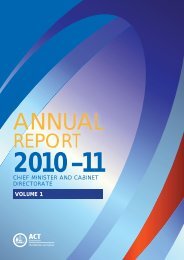Governing the City State - Chief Minister and Treasury Directorate ...
Governing the City State - Chief Minister and Treasury Directorate ...
Governing the City State - Chief Minister and Treasury Directorate ...
Create successful ePaper yourself
Turn your PDF publications into a flip-book with our unique Google optimized e-Paper software.
desires of <strong>the</strong> Legislature to scrutinise <strong>the</strong> actions of <strong>the</strong> Executive, but which also fosters <strong>and</strong>encourages innovation <strong>and</strong> improvements to ACTPS policy <strong>and</strong> program design <strong>and</strong> delivery.The Commissioner for Public Administration’s Submission to <strong>the</strong> Review argued that:The ACTPS must get <strong>the</strong> balance right between process <strong>and</strong> outcomes, <strong>and</strong> betweendelivering services <strong>and</strong> reporting on <strong>the</strong> delivery of <strong>the</strong>se services. In my view, getting <strong>the</strong>balance right will require <strong>the</strong> support of all members of <strong>the</strong> Legislative Assembly <strong>and</strong> perhapsa cultural shift from members as well. Many ACTPS employees report to me that <strong>the</strong>Legislative Assembly currently places too much emphasis on process <strong>and</strong> increased reportingwithout recognising <strong>the</strong> costs associated with this <strong>and</strong> <strong>the</strong> concomitant reduction in emphasison community outcomes <strong>and</strong> <strong>the</strong> delivery of services. 287To address <strong>the</strong>se challenges, those responsible for delivery – <strong>the</strong> Executive – <strong>and</strong> those with<strong>the</strong> power <strong>and</strong> legitimate right to hold it to account – <strong>the</strong> Legislature – need to workcooperatively to ensure that <strong>the</strong> accountability systems put in place by <strong>the</strong> ACT Government<strong>and</strong> <strong>the</strong> Legislative Assembly recognise that “accountability systems that punish publicservants for <strong>the</strong>ir mistakes will constrain policy innovation, <strong>and</strong> limit <strong>the</strong> public service’scapacity to deal flexibly with new <strong>and</strong> emerging problems. 288 That is not, of course, tosuggest that reckless risk taking should be o<strong>the</strong>r than shown for what it is, or that wastage ofpublic money should not be exposed <strong>and</strong> criticised. What it does mean, is that accountabilityprocesses should allow new approaches to be tried, <strong>and</strong> for <strong>the</strong>m to fail provided that lessonsare learnt, experiences are captured <strong>and</strong> new insights are fed back into program design <strong>and</strong>delivery in a proper system of evaluation <strong>and</strong> review, <strong>and</strong> that mistakes are not repeated.Such an approach depends on a transparent <strong>and</strong> open assessment of risk, <strong>and</strong> a system <strong>and</strong>culture that encourages <strong>and</strong> rewards innovation <strong>and</strong> informed risk taking:accountability systems that punish public servants for unforeseen or unpreventableerrors will constrain policy innovation <strong>and</strong> organisational learning, <strong>and</strong> limit <strong>the</strong>289public service’s capacity to deal with new <strong>and</strong> emerging problems.In settling <strong>the</strong> detail of accountability frameworks, it is worth keeping in mind that just asgood people will make bad structures work, “courageous leaders <strong>and</strong> talented staff caninnovate even within a rigid accountability framework, but an overly rigid <strong>and</strong> prescriptiveframework can make this more difficult”. 290It is through cooperation <strong>and</strong> underst<strong>and</strong>ing <strong>and</strong> articulation of purpose, as well as legitimateroles <strong>and</strong> responsibilities of <strong>the</strong> branches of government, that <strong>the</strong> sorts of “fit for purpose”accountability structures favoured by <strong>the</strong> APSC will be able to be developed in <strong>the</strong> ACT. 291Such arrangements would be “tailored to <strong>the</strong> policy issue at h<strong>and</strong>, appropriately balance <strong>the</strong>need to be accountable for <strong>the</strong> use of public resources <strong>and</strong> performance <strong>and</strong> <strong>the</strong> achievement287 Submission No.18. Commissioner for Public Administration.288 Australian Public Service Commission (2009b), p.2.289 Thomas, P. (2006) Performance Measurement, Reporting, Obstacles <strong>and</strong> Accountability: Recent Trends <strong>and</strong> FutureDirections ANU EPress, Canberra, p. 61.290 Australian Public Service Commission (2009b) p.9.291 See for example Australian Public Service Commission (2009c).Strategy, Resource Allocation <strong>and</strong> <strong>the</strong> Vacant Middle Ground: 226



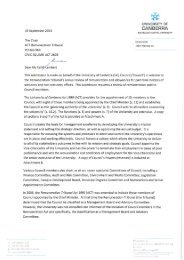
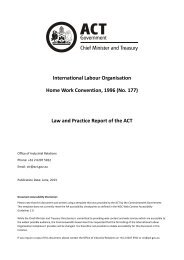
![HSR Training Programs Guidelines [ PDF 191KB]](https://img.yumpu.com/51348280/1/190x245/hsr-training-programs-guidelines-pdf-191kb.jpg?quality=85)






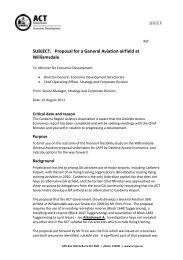
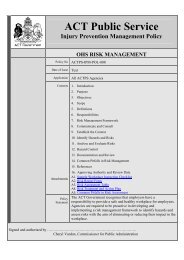

![Teachers Technical and Further Education [ PDF 68KB]](https://img.yumpu.com/34230751/1/184x260/teachers-technical-and-further-education-pdf-68kb.jpg?quality=85)
